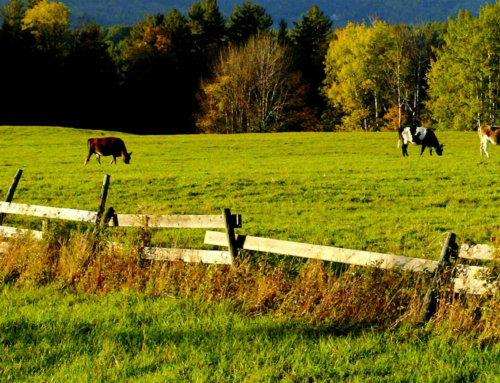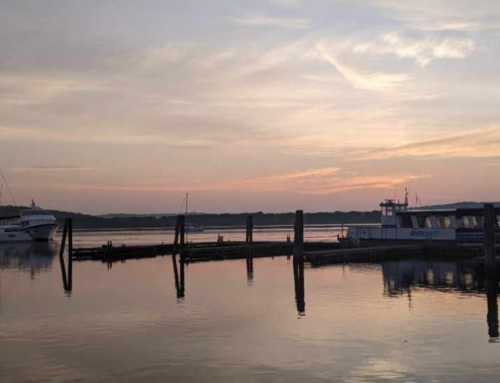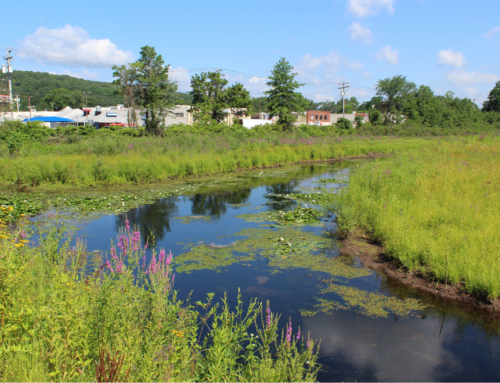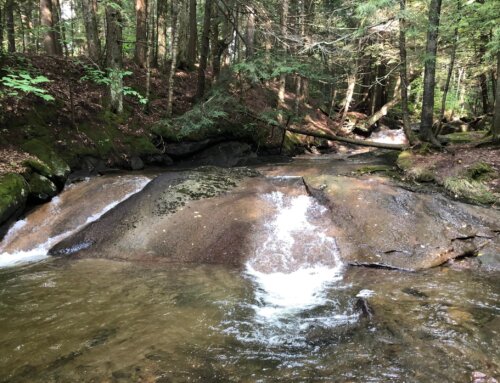Wonderful Wetlands!
On a recent smoky June day a friend and I (Kate, CRC’s NH River Steward) visited the delightful Philbrick-Cricenti Bog in New London NH. The bog is close to the border between the Connecticut and Merrimack River watersheds and hosts a gem of a walk, with boardwalks (no dogs allowed!) that allow for access to view the bog and it’s unique assemblage of plants. The bog is a quaking bog, which means that although it looks solid on the surface, it is very much not; in places there is as much as 20 feet of acidic, nutrient poor, mucky water underneath the surface of sphagnum moss and sedges. This water is key to the bog environment, supporting tundra like plants and others that have evolved to live in the nutrient deficient water and swampy soils. These include black spruce, tamarack, bog rosemary, and the reason I wanted to visit…carnivorous pitcher plants and sundews. The pitchers were not yet blooming when I was there and looked like they had perhaps been nipped by the late frost, but they were abundant!
The bog water also has very low oxygen levels; in combination with the acidity this leads to an anaerobic environment in which the subsurface layers of sphagnum moss do not decay, resulting in the build up of peat over many centuries. I was amazed at the stunning beauty and unique environment of the the bog; it seemed both incredibly fragile and yet timeless, and I was grateful for the Philbrick, Cricenti, and Cleveland families, and the New London Conservation Commission, who along with others have ensured the long-term protection of and access to this property.



My visit to Philbrick-Cricenti came not long after the Supreme Court’s decision on Sackett v. EPA, which narrowed the definition of wetlands subject to federal provisions of the Clean Water Act to those with a “continuous surface connection” to rivers, lakes, ponds, estuaries, or other clearly established “waters of the US.” I wondered whether this magnificent bog would count as a wetland under the narrowed conditions or not…it drains in part to Murray Pond, but is not connected on the surface…and, while the bog definitely contains a lot of water, you wouldn’t know that from just a glance.
In NH, wetlands are defined under RSA 482-A as “an area that is inundated or saturated by surface water or groundwater at a frequency and duration sufficient to support, and that under normal conditions does support, a prevalence of vegetation typically adapted for life in saturated soil conditions.” The NH definition of wetlands requires the presence of hydric soils (saturated enough to produce anaerobic conditions), hydrophytic vegetation (plants adapted to live in hydric soils), and hydrologic evidence that the soil is inundated during the growing season. This would definitely include the bog, but also covers swamps, vernal pools, marshes, forested wetlands, and wet meadows. If land in NH has those three qualities, it’s a wetland! NH jurisdictional oversight of wetlands actually predates the Clean Water Act, beginning in 1969 for non-tidal wetlands. A NH DES blog post acknowledging wetlands indicates that only about 5-10% of land in NH is classified as wetlands, but that these areas contribute over $1 billion in ecosystems services including flood control, pollutant reduction, groundwater recharge, wildlife habitat, immense biodiversity, economic and recreational support, and much more. Wetlands are a critical component of healthy watersheds.
Due to their environmental and economic importance, activities impacting wetlands under NH’s jurisdiction are required to be permitted in accordance with RSA 482-A and Rules ENV-WT 100-900. This includes dredging, filling, excavating, and building or removing structures within a wetland. This is NH law, not subject to the Clean Water Act definition, and as such should not be changed by the recent Supreme Court ruling. There are still many unknowns about how changes at the EPA might ultimately affect wetlands across the US, where reliance on federal versus state definitions and ordinances are varied. Just within NH, wetlands are not always treated equally across town boundaries. Because there is no state-wide setback requirement, some towns require consistent wetland protections through more stringent setbacks, buffers and/or designation of prime wetlands, while other municipalities may only implement the bare minimum permit application requirements. Changing personnel, budgets, and time commitments within local governments can also affect consideration and protection of wetlands. NH state-level wetland permitting does not completely prevent alteration and development of wetlands, it just provides some oversight into where and why it can happen and an avenue for mitigation if it does. Local conservation commissions and river management advisory committees have the ability to comment and “intervene” on these permit applications and their contribution to the process is important and appreciated.
Wetlands deserve our respect and consistent protection for the outsized role they play in keeping our rivers clean and healthy. I hope that many more of NH’s wetlands are afforded the long term protection that Philbrick-Cricenti Bog has, so that all living things can enjoy their beauty and benefit from their existence for years to come.
Kate Buckman, NH River Steward







